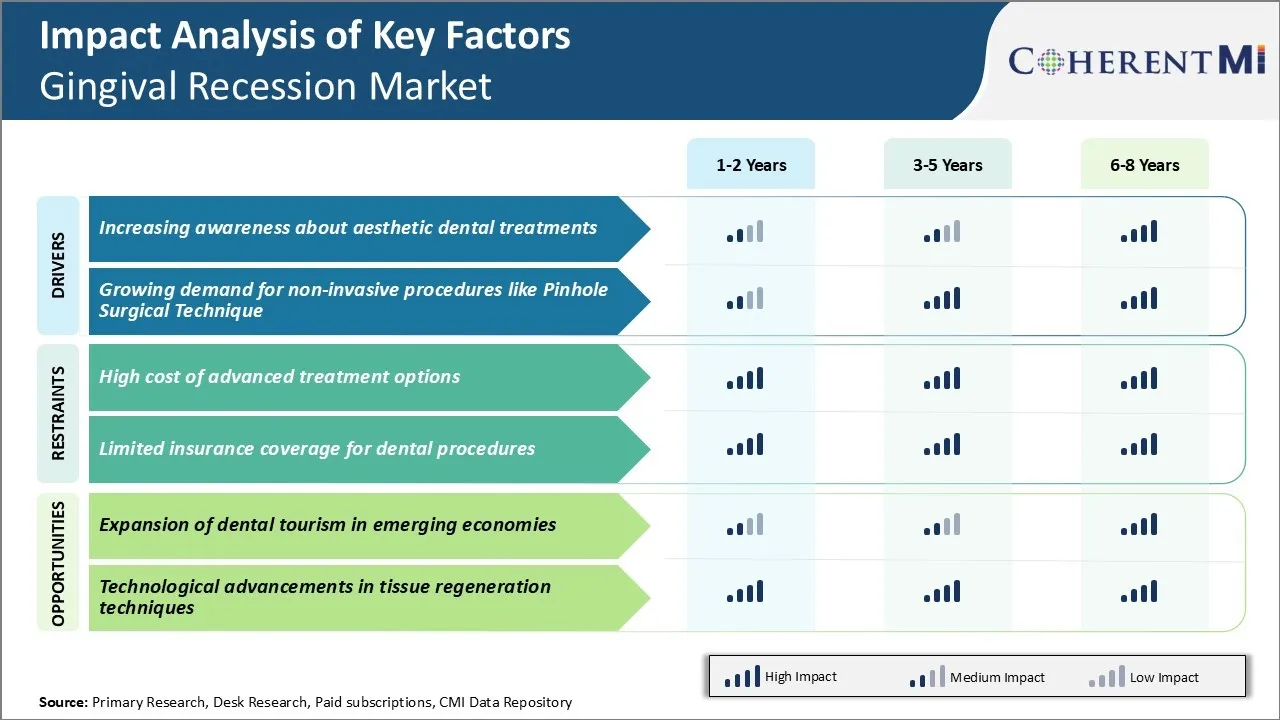Gingival Recession Market Trends
Market Driver - Increasing Awareness about Aesthetic Dental Treatments
With greater exposure to fashion and media through the internet and worldwide advancements in dentistry, people have become increasingly aware of the importance of dental aesthetics. Growing focus on physical appearance and flawed smiles has driven many individuals to seek cosmetic improvements. Gingival recession, where gum tissues pull away from the teeth, is one such condition that can mar the look of one's smile. While previously overlooked, patients today wish to preserve their natural teeth and have youthful looking smiles.
This has pushed more cases of gum recession into the limelight. People now understand recession can result in sensitivity, root exposure and an aged appearance. They recognize correcting it through procedures like gum grafts and regenerative techniques helps mask underlying bone and tooth structure for a balanced smile.
Further, with social media connecting people globally, physical attributes receive more attention than before. A perfect set of white teeth with healthy pink gums has become a desirable, almost mandatory, trait for many. This places psychosocial pressure on those with visible signs of gum recession. The promise of reversing recession's cosmetic impact therefore draws more patients who now value aesthetic dental treatments on par with medical needs.
Market Driver - Growing Demand for Non-Invasive Procedures like Pinhole Surgical Technique
As with other medical fields, there is increasing preference for minimally invasive procedures in dentistry as well. People desire solutions allowing preservation of natural tissues and rapid recovery times. The pinhole surgical technique for gum recession fulfills this need superbly. It involves raising gum flaps and carefully suturing them to the cemento-enamel junction with minimal incisions. This closes gum pockets without necessitating grafting of additional tissues.
Compared to conventional techniques, pinhole surgery causes negligible post-procedural pain and swelling. Patients resume regular activities promptly rather than taking several days off for healing. Minimal sutures also translate to barely noticeable gum lines, avoiding an augmented look. Such predictable esthetic outcomes and convenience spark appeal among working individuals with active lifestyles. They are keen to try protocols respecting natural dental architecture over extensive restorative measures.
Likewise, pinhole attracts a larger segment by being less technique sensitive. It does not demand complex flap manipulations or membrane placements common to grafting procedures. This reduces the skill level, learning curve and chair-time associated with addressing recession cases. It has potential for wider adoption by general dentists beyond specialists. As a result, more practices are investing in pinhole surgery, expanding its availability.

Market Challenge - High Cost of Advanced Treatment Options
One of the major challenges being faced by the gingival recession market is the high cost of advanced treatment options for gingival recession such as gingival grafting. Gingival grafting involves surgical procedures where periodontal cells or tissues are transplanted from one area of the mouth to another area to cover exposed root surfaces. These surgical procedures require advanced equipment, specially trained periodontists, specialized surgical skills and involve a long recovery time for patients. All of these factors contribute to making gingival grafting a very costly procedure, often exceeding $1,000-$2,000 per affected site. This high cost puts it out of reach for many patients suffering from gingival recession, especially those with low income or no dental insurance coverage. Many patients simply cannot afford such expensive treatments and either live with the condition or opt for less effective non-surgical options. This significantly impacts the potential demand and growth prospects for advanced treatment modalities in the market. Unless new technologies are able to drive down costs or more affordable alternative procedures are introduced, high treatment expenses will continue to restrict the gingival recession market size.
Market Opportunity - Expansion of Dental Tourism in Emerging Economies
One significant opportunity for growth being presented to the gingival recession market is the expansion of medical and dental tourism industries in emerging economies. Countries such as India, Thailand, Mexico and Hungary have been actively promoting themselves as popular low-cost destinations for dental procedures and cosmetic dentistry.
Dental facilities in these countries are able to offer treatment for conditions like gingival recession at a fraction of the cost compared to developed markets like the United States and Western Europe. This cost advantage is attracting significant numbers of international patients travelling to these emerging countries specially for dental treatments.
As awareness increases about affordable dental tourism options, it will help drive the demand for treatments of gingival recession globally. This provides an opportunity for clinicians as well as product manufacturers in these low-cost markets to tap into the expanding dental tourism industry and boost their share of the worldwide gingival recession market.